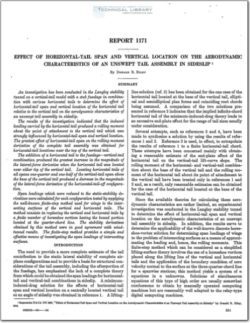NACA-Report-1171

- Version
- 201 Downloads
- 1.63 MB File Size
- 1 File Count
- December 4, 2015 Create Date
- December 4, 2015 Last Updated
National Advisory Committee for Aeronautics, Report - Effect of Horizontal Tail Span and Vertical Location in the Aerodynamic Characteristics of an Unswept Tail Assembly in Sideslip

An investigation has been conducted in the Langley stability
tunnel on a vertical-tail model with a stub fuselage in combina—
tion with various horizontal tails to determine the efiect of
horizontal-tail span and vertical location of the horizontal tail
relative to the vertical tail on the aerodynamic characteristics of
an unswept tail assembly in sideslip
The results of the investigation indicated that the induced
loading carried by the horizontal tail produced a rolling moment
about the point of attachment to the vertical tail which was
strongly influenced by horizontal-tail span and vertical location.
The greatest efiect of horizontal-tail span on the rolling- moment
derivative of the complete tail assembly was obtained for
horizontal-tail locations near the top of the vertical tail.
The addition of a horizontal tail to the fuselage—vertical-tail
combination produced the greatest increase in the magnitude of
the lateral-force derivative when the horizontal tail was located
near either tip of the vertical tail. Locating horizontal tails of
all spans one-quarter and one-half of the vertical—tail span above
the base of the vertical tail produced a decrease in the magnitude
of the lateral-force derivative of the horizontal-tail—ojr configura-
tion.
Span loadings which were reduced to the static-stability de-
rivatives were calculated for each configuration tested by applying
the well-known finite-step method used for wings to the inter-
secting surfaces of the vertical and horizontal tails. The
method consists in replacing the vertical and horizontal tails by
a finite number of horseshoe vortices having the bound portion
located at the quarter-chord line. The stability derivatives
obtained by this method were in good agreement with wind-
tunnel results. The finite-step method provides a simple and
efiective means of investigating the span loadings of intersecting
surfaces.
| File | Action |
|---|---|
| naca-report-1171.pdf | Download |

Comment On This Post